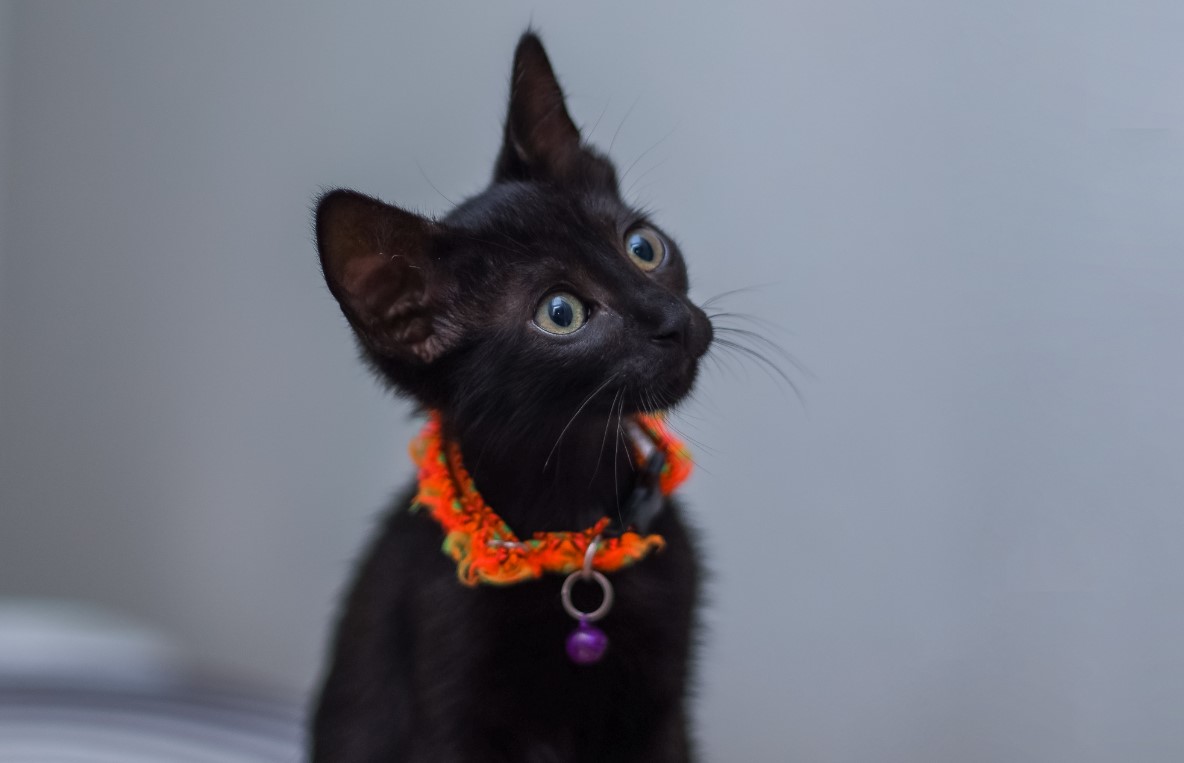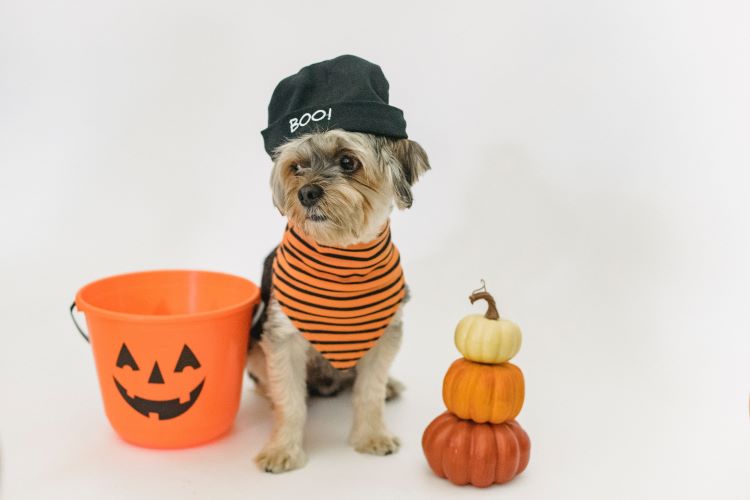Ready to help treat your pet to a healthy life?
A Human's Guide to Pet-Safe Halloween Costumes in 2024
By : Trupanion Staff | Updated Oct 3, 2024

Everyone has their own favorite ways to celebrate Halloween, and for many pet owners this includes dressing up dogs and cats in fun (or scary!) costumes. After all, why not include the whole family on the spooky fun?
If you're already planning on some festive getup for your pet, you're not alone. Halloween shopping research data shows that American pet owners budget $700 million for cat and dog costumes across 2021, 2022, and 2023 — 17.1% of all costume expenditures! And with things like the "Batman cat mask" already making headlines as the next hottest trend of Halloween 2024, this season seems to be on the same trajectory.
But before you go trying to bring out your pet's inner superhero, it's imperative that you're putting their wellbeing first. Halloween costumes aren't for every pet, much as we'd like them to be. You'll need to be careful to ensure you aren't creating unnecessary stress for your pal. Even if you're used to dressing up your pet, the wrong choices could lead to dangerous consequences.
Fortunately, there are plenty of things you can do to practice safety with pet costumes and ensure everyone has a good time. Here's a quick guide on dressing up dogs and cats safely this year as well as how to choose a pet-safe Halloween costume in the first place.
Choosing the right costume
It's Howl-o-ween time! If you don't already have a costume for your pal, now's the perfect time to pick one out. But before you do, let's go over some ground rules and what to look for. After all, a poor pet costume decision could result in anything from unnecessary stress and discomfort for your pal to an emergency vet visit.
Your pet's preferences
To save you time and money on an expensive pet costume, start by determining if your furry friend is okay with wearing anything to begin with. For example, a cat that can't stand wearing a harness isn't likely to suddenly enjoy having little plush dragon spikes strapped to their back.
If your pal has never worn a costume or even a pet harness before, try starting with a harness. If they're comfortable with that, try a pet sweater. Happy pet and no problems? You're probably good to try a costume.
Keep it simple
While big statements and extravagance may be fine for human costumes, they can pose a danger to pets. Your pet's Halloween attire should be on the simple side, with as few pieces as possible to complete the look. Avoid extra accessories, detachable parts, or anything that can become tangled. In other words, your pet's costume should never restrict their movement.
Remember that your pet is perfectly comfortable without clothing. There's also no way to explain costume contests, how adorable they look, or even the concept of Halloween to them — dressing pets up is mostly just for human fun. So, for many dogs and cats, just a simple vest or harness will be the perfect choice. For those who don't like things wrapped around them, consider opting for just a festive collar.

Safe pet costume materials
Many cat and dog costumes are designed more for the ease of the pet owner rather than the animal. So, it's important to consider things from your pet's perspective and needs. The best pet costumes are entirely cloth or plush material, with no hard pieces that could scratch or harm your pet. Opt for Velcro over zippers, and stay away from buttons, sequins, bows, and ribbons (or anything your pet may be able to tear off and chew).
Your pet's ability to see while in costume is also important. While they may look funny in a mask or glasses, these items can easily obstruct a pet's vision and stress them out (in addition to creating unnecessary danger). Not sure if something is safe for your pet? Just give their veterinarian a call to ask!
Costumes aren't for every pet
It can't be stressed enough that Halloween is best enjoyed when everyone is having fun, including pets. While costumes are fun for people, they are often less-so for pets. Some pets just do not like dressing up, no matter the occasion or material of the costume.
Signs you should remove your pet's costume:
- Flattened ears / ears pinned back
- Lip licking (dogs)
- Whining (dogs)
- Panting
- Shaking
- Hissing (cats)
- Repeated meowing (cats)
- Going limp or generally refusing to move while in costume
- Repeated yawning
- Wide, fearful eyes
- Shrinking away from you
- Repeated scratching or biting at themselves
- Attempts to rip the costume off
Keep in mind that pets can react differently to stress factors, so any change in behavior should be noted. The point is, If your dog or cat is acting anxious or just isn't having a good time, don't force things. Simply remove the costume and avoid dressing them up further. At the end of the day, no photo is worth sacrificing your pet's comfort and wellbeing.

More pet Halloween costume safety tips
For pets that are fine with wearing Halloween costumes, practicing safety is still of the utmost importance. In addition to being ready to remove your pal's costume the moment you notice any signs of stress, follow these tips whenever your pet is dressed up to avoid disaster.
1. Make adjustments for your pet
Always tailor your pet's Halloween costume so it is safe and comfortable for them. Cat costumes are often one size fits all, while dog costumes typically range in small, medium, and large. Depending on your particular pet's shape and dimensions, you may need to make some adjustments to ensure that the costume fits around them correctly. Avoid making it too loose, as this could lead to skin irritation from friction or even just cause your pet to trip.
2. Avoid accessories
Your pet doesn't need add-ons to complete their look — jewelry and small, separate pieces can be a choking risk. It can also be tempting to put glow sticks on your pal if you're taking them out during the evening, but these are not a good idea either. Not only can many glow stick designs also pose a choking hazard, but they can be toxic if chewed on.
3. Limit costume time
Even pets who are perfectly fine with being dressed up shouldn't be kept that way all day long. Otherwise safe Halloween costumes can still cause discomfort and even irritation if left on too long. It's also important to keep your pet's temperature in mind, especially when it comes to thicker costumes and those with hoods and plush pieces. Dogs and cats already have natural fur coats, so prevent overheating by not keeping their costumes on indoors for more than an hour. If they have thick fur and/or their costume is particularly thick, try to just snag some cute photos and remove the costume as soon as possible.
Unsure of how long it's okay to keep your particular pet dressed up? Consult with their veterinarian, who will be able to provide better insight into the overheating risks with their age and breed.
4. Keep collars and ID tags on
Going trick or treating with your pet? Be sure to keep their collar and ID tags on, even if it means compromising the "aesthetic" of their costume or having to remove part of said costume (hey, if there's not enough room around their neck for the collar to sit comfortably, the costume is probably ill-fitting anyway). On that note, you'll also want to consider microchipping your pet if you haven't yet. Unlike an ID tag that could possibly come off, a microchip sits safely below their skin and can help reunite the two of you even if they are found without a collar and traditional identification.

5. Don't sacrifice safety for fun
Remember; Halloween costumes and pet safety go hand in hand. Avoid an unexpected trip to the veterinary clinic during this spooky season by keeping all candy well out of reach from your pet. And again, be prepared to remove the costume if your pet isn't having a good time. You wouldn't want to cause your pet to be stressed on what's otherwise supposed to be a fun day!
Check out more fall pet safety tips to keep dogs and cats out of trouble all season long.
